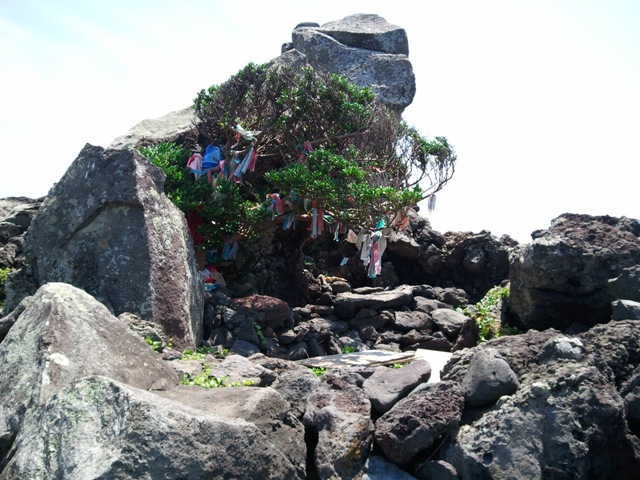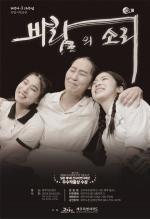 |
||
| One of the variety of halmang-dang found across Jeju Island. Photo by Anne Hilty | ||
Jeju shamanism is rife with goddesses.
The shamanic shrines dotting the island, approximately 400 of them remaining as cataloged in research conducted by the Jeju Traditional Culture Institute in 2009 and 2010, are largely in homage to female deities.
Called “halmang-dang,” the components in Jeju dialect refer to elder woman - “halmang,” the local equivalent of “halmeoni” in the mainland: grandmother, in regard to age; goddess, in ultimate seniority; both, in honor due – and “dang,” a shrine or a place of worship located in nature.
Going to the Goddess shrine is like visiting one's grandmother: one can say anything to Her, for She is not judgmental but open, loving, benevolent, consoling, forgiving, and a gentle teacher -- unlike the "strong" mother often-perceived as a strict disciplinarian. While Jeju goddesses may be of any age, some even youth, these qualities nevertheless apply.
In fact, halmang-dang typically have both goddesses and gods in attendance; multiple deities are present, though some are primary, often "husband and wife." It is the goddess who is prominent, however, governing birth, death, and prosperity while the god is generally in the role of guardian or consort. In many a single “jedan” [altar] is shared, while in others there are two -- the central one for the goddess, and a lesser one, often guarding the gate, for the god.
“Bon-hyang-dang” [main village shrine], in comparison with halmang-dang, are generally limited to either one deity only or to a paired goddess and god, patrons of the village, and one central jedan. In the highly unusual case of the Waheul Village bon-hyang-dang, there are two jedan, deliberately separating the worship of goddess and god based on a myth about controversy between this sacred “husband and wife.”
On the mainland, the “sin-dang” or spirit shrine can be perceived as daunting or even frightening; on Jeju, however, it is a place to metaphorically visit one's beloved grandmother. The goddess of each shrine has unique heritage and characteristics.
As with most religious traditions, and particularly in Jeju's matrifocal culture, women have been the primary devotees; this segregation became pronounced during the Joseon era, at which time Neo-Confucianism became the state-sanctioned, male-oriented social order, while shamanism was distinctly woman-focused and in contradiction to the former.
The goddesses wait at their shrines contentedly, like a grandmother -- except the goddess of fortune, Gamunjang-Agi, who is expectant and requires mutual aid. One mustn't arrive late, however, because - like any of the grandmothers on Jeju - the resident or patron goddess of such a shrine has a full day of work to do. Devotees traditionally arrived at or as close to sunrise as possible, the only time that the deity was assured to be in residence.
If one must come to the dang later in the day, one could pour one's lament, concern or request onto a white sheet of paper - literally writing on it, or imbuing it with one's emotions, and held close to the heart for a period of time - then placed between branches of the central tree or in a crevice of the god-rock, in a gesture of sympathetic magic. Men typically seek answers to their problems; women, however, tend more toward comfort and the simple opportunity to express their feelings, trusting the "answers" that already reside within. The halmang-dang has provided them with a place to do just that.
The shrine is always "rooted" in a natural setting chosen by legend, precognitive dream, geomancy, “simbang” (shaman) communication with local gods, or site of the god's death (if a posthumously deified human, a not-uncommon Jeju practice). Essential to Siberian shamanistic tradition is a central or cosmic tree that serves as “axis mundi,” and a stone jedan typically carved from the ubiquitous basalt of this volcanic island.
In the past, there were six to seven halmang-dang per village, sometimes as many as 10, and devotees could visit the shrine on any day of the month. Today, however, while there are approximately 400 shrines still in existence on the island, many are in grave disrepair and unusable; there are typically only one to two per village, so their use is regulated to three days per month as well as on special occasions. According to the resident deity's preference, this is either on "seventh" (7th, 17th, and 27th) or "eighth" (8th, 18th, and 28th) days. The “haesin-dang,” halmang-dang located at the coast, conversely are open to the use of 'haenyeo' or female free-divers whenever needed, and to other village members according to schedule.
The bon-hyang-dang serves as a "general hospital" -- that is, for all concerns, and for four annual village “dang-gut” (shrine rituals). Other shrines are often for specific circumstances according to the deity in residence: childbirth/rearing, fortune, snake worship, specific health conditions, etc.
Shrines to “dokkebi” or “yonggam” (goblins or dubious spirits, respectively) also exist, though rarely to “harubang” (grandfathers). At dokkebi or yonggam shrines, fishermen pray to be spared from the spirits' malevolence; gods of fire can also be in residence, and worship of them is meant to prevent house fires.
The spirits of these shrines are thought to be mischievous, capricious, and changeable. They are sometimes perceived as "wanderers" without a spiritual home, who are only visiting the shrine and who act on their feelings impulsively, bringing more disasters than fortune, and who therefore must be appeased. In the traditional mask dance of the region, one player always holds fire to amuse these creatures, and prosecutors were historically dubbed “yonggam.”
“Dang-gol,” or shrine devotees, are ranked according to a three-tiered hierarchy: “sang-dang-gol” (sang: high) are the most devoted, attending approximately three times monthly, tending to the shrine, and known as such to all villagers; “chung-dang-gol” (chung: middle) are of medium devotion, generally worshiping monthly; and “ha-dang-gol” (ha: low) represent the least devoted, who attend annually or rarely. At the annual village dang-gut, the dang-gol arrive very early to obtain a favorable site for their offerings; sang-dang-gol always place their offerings in a central place of honor on the jedan.
Prior to worshiping at the shrine, one must cleanse oneself and wear clean or even new clothes, traditionally white. In addition, there are numerous taboos for a week or more leading up to the day of worship, such as prohibitions against liquor consumption, fighting or conflict, bloodletting including the killing and butchering of animals for food or sacrifice, the sight of blood or menses, sexual activity, visiting the ill or diseased, and many other 'contaminating' activities. Dang-gol must be free from conflict, particularly important for the 4 annual village dang-gut which are to bring health and prosperity to all villagers. Historically, the presiding simbang would visit the village days in advance of the dang-gut, consult with the village leaders regarding any conflicts among villagers, and act as mediator of same. In this collective process, all villagers understood their responsibility in resolving conflict so that the gods would look favorably upon their village.
Devotees carry their offerings in a basket on their arm or back and as such are obvious to other villagers they meet, who refrain from speaking to them so as not to disturb their communion with the spirits or taint their purification. During and even directly following any dang-gut, one mustn't talk, ask questions, or otherwise disturb devotees or simbang; in a home ritual, visitors are prohibited for several days before and after.
For the dang-gol are walking in spirit. Grandmother-spirit. Goddess.
–
Kim Soonie, Jeju native, is a mythologist and Jeju representative of the nation's Cultural Heritage Administration. Anne Hilty is a cultural health psychologist from New York who now makes Jeju Island her home. Interpretation / translation was provided by Han Youngsook, Jeju native and instructor at Jeju National University.
Kim Soonie and Anne Hilty eastwest.psyche@gmail.com
<저작권자 © 제주위클리 무단전재 및 재배포금지>






